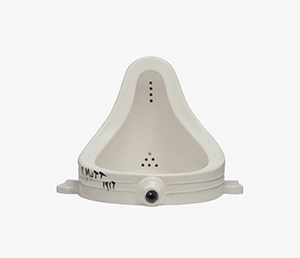Fontana Marcel Duchamp
Duchamp utilizzò per primo in ambito artistico il termine ready-made nel 1913 in relazione alla sua opera Bicycle Wheel (categorizzabile come ready-made rettificato, in quanto si tratta di una ruota di bicicletta imperniata su di uno sgabello tramite le forcelle del telaio). Il primo ready-made puro è Bottle Rack (“Lo scolabottiglie”, del 1914), semplicemente firmato. L’originale dello scolabottiglie non esiste più.
Esso fu semplicemente buttato via dalla sorella di Duchamp (alla quale lui regalò nel 1914 il Readymade Infelice – Unhappy Readymade – mentre questi, nel 1915, era negli Stati Uniti ed ella aveva compiuto una “pulizia generale” dello studio del fratello. Ma lo stesso Duchamp lo sostituì poi con un altro esemplare.
Nonostante i ready-made siano carichi di una forte componente ludica ed ironica, molti critici non escludono che Duchamp, fortemente interessato all’alchimia, abbia inserito nelle sue opere simboli tipicamente alchemici. Un esempio sarebbe dato da Lo scolabottiglie che richiamerebbe il simbolo dell’albero. Un secondo esempio sarebbe dato da Fontana che simboleggerebbe l’utero femminile e non a caso Duchamp l’avrebbe firmata con lo pseudonimo “R.Mutt”, che traslitterato evoca fonicamente il sostantivo tedesco Mutter, che significa “madre”.
Source Wikipedia, the free encyclopedia
This article is about the Readymades of Marcel Duchamp
Marcel Duchamp coined the term ready-made in 1915 to describe a common object that had been selected and not materially altered in any way. Duchamp assembled Bicycle Wheel in 1913 by attaching a common front wheel and fork to the seat of a common stool. This was not long after his Nude Descending a Staircase was attracting the attention of critics at the International Exhibition of Modern Art. In 1917, Fountain, a urinal signed with the pseudonym “R. Mutt”, and generally attributed to Duchamp, confounded the art world. In the same year, Duchamp indicated in a letter to his sister, Suzanne Duchamp, that a female friend was centrally involved in the conception of this work. As he writes: “One of my female friends who had adopted the pseudonym Richard Mutt sent me a porcelain urinal as a sculpture.” Irene Gammel argues that the piece is more in line with the scatological aesthetics of Duchamp’s friend, the Baroness Elsa von Freytag-Loringhoven, than Duchamp’s. Research by Rhonda Roland Shearer indicates that Duchamp may have fabricated his found objects. Exhaustive research of mundane items like snow shovels and bottle racks in use at the time failed to reveal identical matches. The urinal, upon close inspection, is non-functional. However, there are accounts of Walter Arensberg and Joseph Stella being with Duchamp when he purchased the original Fountain at J. L. Mott Iron Works.
Source: Wikipedia, the free encyclopedia













